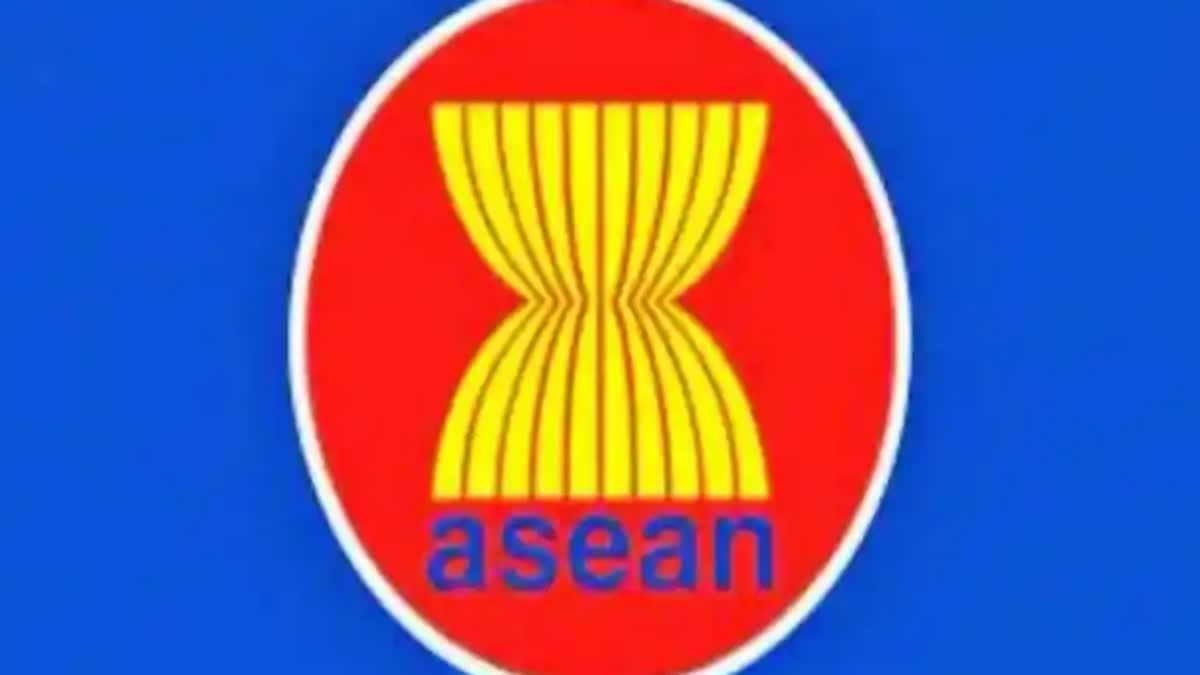New Delhi: With the Fourth Joint Committee meeting for the review of Association of Southeast Asian Nations (ASEAN)-India Trade in Goods Agreement (AITIGA) being held in Putrajaya, Malaysia, last week, the focus is again back on the role India’s northeastern region can play in this regard.
After all, this is the region that is in closest geographical proximity to the ASEAN countries. In fact, New Delhi formulated the Look East Policy in the early 1990s and the Act East Policy in 2014 precisely to leverage this geographical proximity.
According to K Yhome, Fellow at the Shillong-based Asian Confluence think tank, the Indian government and the ASEAN have the intent to explore opportunities in the Northeast to strengthen bilateral ties between New Delhi and the 10-nation bloc. “The Northeast definitely finds centrality in the larger policy framework,” Yhome told ETV Bharat.
The ASEAN is one of the major trade partners of India with a share of 11 per cent in India’s global trade. However, the fact of the matter is that the Northeast’s potential is yet to be exploited to boost bilateral economic and political ties between India and the ASEAN.
For example, though India-ASEAN bilateral trade stood at $122.67 billion in 2023-24, the Northeast accounted for only a meagre five per cent of it. The rest of the trade originated from states in other parts of India. Now, with the fourth AITIGA review meeting being held, speculations arise how the Northeast can play a more prominent role in the trade framework..
According to a statement issued by the Ministry of Commerce and Industry, the discussions for review of AITIGA, to make it more trade-facilitative and beneficial for businesses across the region, started in May 2023.
“A total of eight sub-committees have been constituted for dealing with different policy areas of the Agreement in the review and out of these, five sub-committees have started their discussions,” the statement read. “All the five sub-committees reported the outcomes of their discussions to the Fourth AITIGA Joint Committee. Four of these Sub-Committees dealing with ‘National Treatment and Market Access’, ‘Rules of Origin’, ‘Standards, Technical Regulations and Conformity Assessment Procedures’ and ‘Legal and Institutional Issues’ also met physically in Putrajaya, Malaysia, alongside the Fourth AITIGA Joint Committee. The sub-committee on sanitary and phytosanitary had met earlier on 3rd May 2024. The Joint Committee provided necessary guidance to the sub-committees.”
What is the AITIGA and when did it come into force?
The AITIGA is a comprehensive trade agreement between the ASEAN and India, aimed at promoting bilateral trade and economic cooperation. Negotiations for the agreement began in 2003 and were concluded in 2009, with the agreement entering into force on January 1, 2010.
One of the central objectives of AITIGA is the reduction and eventual elimination of tariffs on goods traded between ASEAN member states and India. Under the agreement, both sides have committed to gradually reducing tariffs on a wide range of products over specified periods. These measures include simplifying customs procedures, enhancing transparency, and reducing non-tariff barriers to trade, thereby making it easier and more cost-effective for businesses to engage in cross-border trade.
The agreement establishes rules of origin criteria, which define the conditions under which goods are considered as originating from either ASEAN or India. This is important for determining eligibility for preferential tariff treatment under the agreement.
The AITIGA includes provisions allowing for the application of safeguard measures in cases where imports of certain goods cause or threaten to cause serious injury to domestic industries. These measures are intended to provide temporary relief to affected industries while allowing for adjustments to take place.
The agreement includes a dispute settlement mechanism to address disputes that may arise regarding its interpretation or implementation. This mechanism provides a structured process for resolving disputes through consultation and negotiation, with the possibility of escalating the matter to arbitration if necessary.
The AITIGA also includes provisions for cooperation and capacity building between ASEAN and India in areas such as trade facilitation, customs administration, and technical standards. This is aimed at enhancing the ability of both sides to fully benefit from the opportunities created by the agreement.
So, why has the AITIGA that came into force in 2010 not been able to boost India-ASEAN trade?
One of the primary issues with AITIGA is the inverted duty structure. This refers to the situation where tariffs on raw materials are higher than those on finished goods. Indian traders have flagged concerns that ASEAN nations impose higher taxes on raw materials sourced from India compared to the duties on finished goods exported to India. This disparity makes Indian raw materials more expensive and less competitive, discouraging Indian businesses from leveraging the agreement.
Non-tariff barriers (NTBs) such as stringent standards, complex customs procedures, and regulatory requirements have posed significant challenges. While AITIGA focuses on tariff reduction, NTBs continue to restrict the smooth flow of goods. These barriers include sanitary and phytosanitary measures, technical barriers to trade, and other administrative and bureaucratic hurdles that complicate the trading process.
The utilisation rates of the preferential tariffs under AITIGA have been relatively low. Many businesses, particularly small and medium enterprises (SMEs), are either unaware of the benefits or find the process to claim these benefits too complex and cumbersome. The lack of awareness and the procedural complexity discourage firms from taking advantage of the agreement.
Although AITIGA includes provisions for trade facilitation, the actual implementation has been inconsistent. Efficient customs procedures, seamless logistics, and infrastructure development are critical for maximising the benefits of the agreement. In many ASEAN countries and India, the pace of implementing these trade facilitation measures has been slow, resulting in delays and increased costs.
Geographical distance and infrastructural limitations have also played a role. This is where the northeastern region of India comes into play.
What are the challenges in leveraging the Northeast in boosting India-ASEAN trade?
Yhome explained that since the turn of the century and in the 2000s, a number of diplomatic and business delegations from the ASEAN visited the Northeast primarily to explore business and investment opportunities in the region.
“Their main takeaway is that the region has the potential because of the geographical proximity,” he said. “Talking to them, one gets the feeling that while people-to-people and cultural ties are upbeat, challenges like governance, ease of doing business, connectivity and security are discouraging them from taking the process forward.”
In terms of governance, the ASEAN has found that the northeastern states have poor institutional mechanism to handle issues such as corruption, efficiency, accountability and monitoring implementation of projects.
Here, the issue of infrastructure also comes into focus. The infrastructure in the region is very poor compared to other parts of India. Yhome explained that what must have put off the ASEAN from investing in the Northeast is that, in terms of logistical wherewithal, the region is lagging way behind other parts of India.
According to Yhome, barring Assam’s main city of Guwahati, other states of the region have not set up systems or created an environment that is conducive for ease of business. Making people engaging in malpractices accountable is a major challenge in the region
On the connectivity side, though the Northeast is in close proximity with Southeast Asia, land connectivity is yet to materialise because of the endless political turmoil in Myanmar. Any interaction that happens between Southeast Asia and northeastern India has to pass through Myanmar.
The 1,360-km-long India-Myanmar-Thailand trilateral highway project connecting Moreh in Manipur and Mae Sot in Thailand has long been delayed due to the situation in Myanmar. Actual construction work on upgrading road segments began around 2012 in all three countries. However, due to political instability and civil unrest in Myanmar, 30 percent of the work is yet to be completed.
“As of now trade between India and the ASEAN nations is mainly happening through maritime and aerial routes,” Yhome said. “But it is the land connectivity between the Northeast and Southeast Asia that the ASEAN countries are more interested in because then it will become a permanent feature.”
On the security side, what is putting off the ASEAN from engaging with the Northeast are issues like insurgency and demands by various political outfits for autonomy or full independence from India. “Perhaps, they are thinking that they need more time,” Yhome said. “The region needs more time to attain political stability.”
So, what is the potential of trade between northeastern India and Southeast Asia?
“The biggest potential of the Northeast is its natural resources,” Yhome said. “In terms of products, primary goods can be exported from the Northeast and not manufactured goods as industries are minimal in the region. They are interested in agro-based industries as the region is rich in organic fruits and vegetables. Processing of such agricultural products is of interest for them.”
Another area sector is tourism. Northeast India and Southeast Asia share historical, cultural and religious (Buddhist) ties. The ASEAN countries can invest in the hospitality sector.
Human resources in the Northeast is an area that the ASEAN can benefit by investing in. Youth in the region can be imparted training for capacity building and skilling. They can then go to the Southeast Asian nations as migrant workers.
According to Yhome, the ASEAN member states can also invest in small and medium enterprises (SMEs) in the Northeast. In this connection, he cited bamboo as an example.
However, at the end of it all, things will not progress as long as the ASEAN nations remain convinced about political stability and infrastructure development in the Northeast.
Read More:



